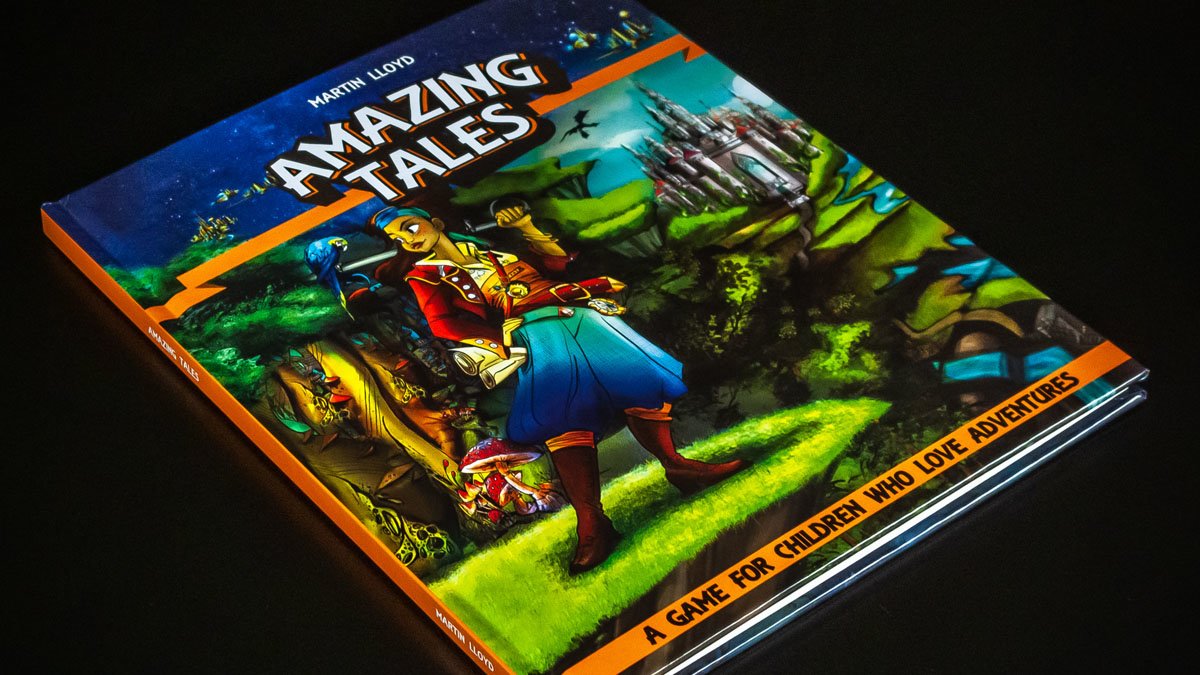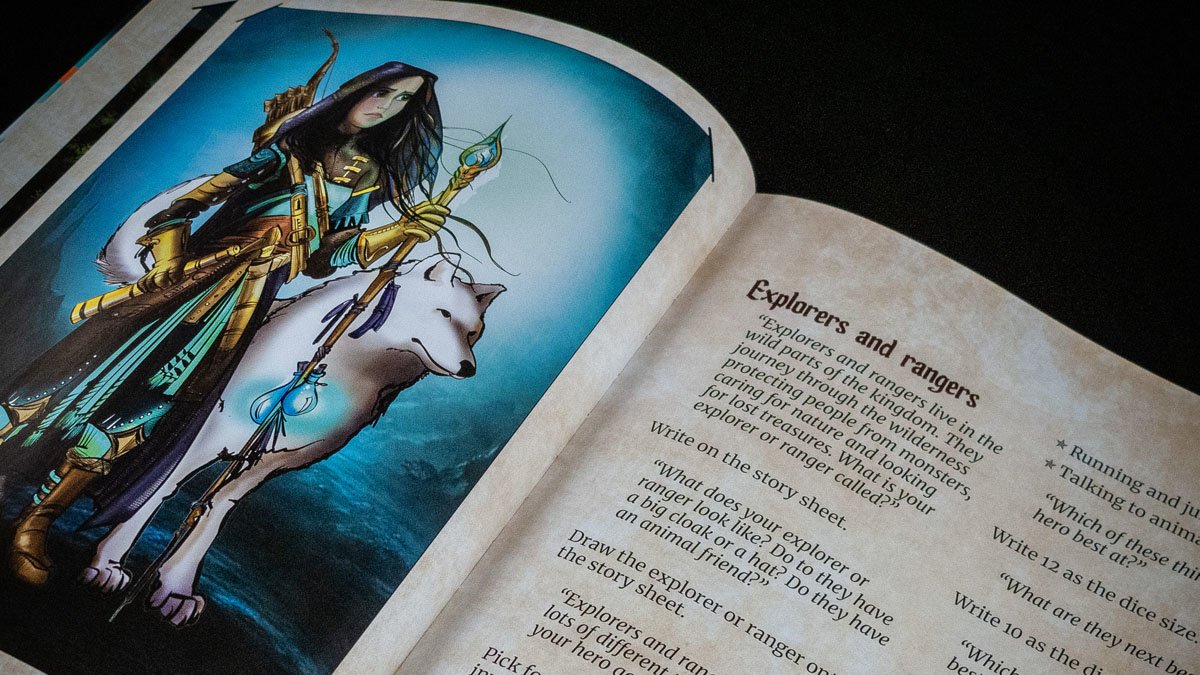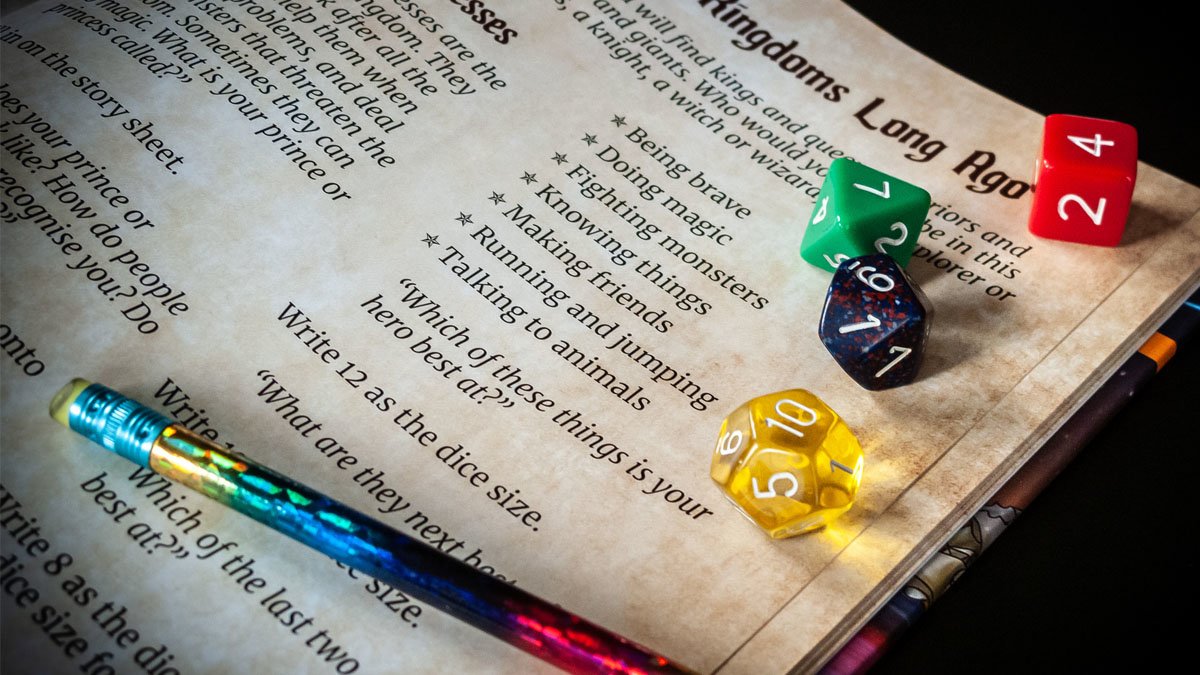
Though my daughter is getting older, and probably about ready to handle the complexity of Dungeons & Dragons, I’m still on the lookout for great tabletop role-playing games for kids that are fun to play and keep young players interested.
Martin Lloyd’s Amazing Tales says it delivers an RPG experience for kids as young as 4. Well, I am intrigued. Let’s check it out!
What is the book like?
Amazing Tales arrived as a 96-page hardcover tome. The book is super-solid in quality and looks great on a bookshelf, with full-color and black & white illustrations by Iris Maertens. The art is colorful, bright, and works very well in conveying an imaginative adventure environment appropriate for young children. The whimsical character art shows diversity in regards to gender and race.
Overall, Amazing Tales is a nice production.

What do you need to play?
Amazing Tales uses four polyhedral dice (d6, d8, d10, & d12) that you’ll need to procure; although suggestions are provided for using a single six-sided die. You’ll also want a pencil and a piece of paper to create a hero and your imagination. It’s as simple as you can get.
What are the settings for adventures?
Amazing Tales includes four sample settings to craft stories:
- The Deep Dark Wood, featuring fairies and talking animals
- Magical Kingdoms Long Ago, featuring princes/princesses, knights, wizards/witches, explorers and rangers
- Pirate Seas, featuring swashbuckling pirates
- Adventures Beyond The Stars, featuring space explorers, aliens, and robots
In each of these settings, options are given for playing the above types of featured heroes along with suggestions of skills to get started. Also, every setting has a few pages of simple story hooks and tips on how to make stories in that space, as much of the creative heavily-lifting will be on the adult running the game.

How does the hero creation work?
Creating a hero in Amazing Tales is as simple as describing who and what the hero is, giving them a name, describing what they look like, and deciding on four specific skills they excel at.
The player assigns each skill a die depending on how good the hero is at that skill. For example, a pirate-themed hero may have Swashbuckling, Navigation, Treasure Hunting, and Being Daring as their four skills. If the player chooses Navigation as the top skill, they would assign a d12 to Navigation. The next best skill, let’s say Being Daring, would have a d10, then the next one a d8, and so on. Then you are ready to play!
What are the rules of the game?
All of the rules fit on a single page, on page 4, to be precise.
The adult, as the gamemaster (GM), starts telling the story, using a hook from the book, or making something up on the fly. At a point where it’s time for a player to decide what do next, the GM asks “What do you do?”
If the action is something that could fail, the GM decides on a skill that seems appropriate and the player rolls the associated die. Any result that is a three or higher is a success; any value lower and the action fails. The GM describes what happens depending on the roll, pass or fail. The story continues until it reaches a conclusion, whatever that may be. That’s it.
It’s important to remember that Amazing Tales is designed for younger kids, so it has to keep things really simple.

What’s the verdict?
The part of Amazing Tales that shines is not necessarily the ruleset, but the tips and tricks for the adult running the game, particularly situations where you don’t want to say “no, you can’t do that”, which stops a story dead in its tracks, but saying ” yes, but…” and continue on.
Really, this is good GM 101 stuff for anyone. Kids are phenomenal at coming up with strange and surprisingly clever solutions to challenges, so keeping your creative chops up is key.
Amazing Tales seems to be written with the assumption that only one child and one adult are participating. I’m sure that multiple players could participate in a story, but if you are looking to engage a group of players (especially older ones) Monte Cook’s No Thank You, Evil might be a good step, or even the aforementioned Tails of Equestria, if the kids are into Hasbro’s colorful ponies. However, these games are more of an investment than Amazing Tales, which you can literally play anywhere at any time, as long as dice are handy and everyone is feeling creative. No table is needed.
I think Amazing Tales would work great with ages as young as 4, as advertised, which is unusual territory for an RPG. Of course, it can be a launching pad for grownup D&D adventures years later, but it seems that Amazing Tales would provide a more natural progression into games which emphasize narrative play over simulating realism, like Dungeon World or anything that uses Powered By The Apocalypse game mechanics.
I recommend checking out Amazing Tales for any young kids who love imaginative storytelling, and parents looking to step up their GM game. Everyone wins here!
Disclosure: I received a copy of this book for review purposes.




Picked up a copy of this during DriveThru’s recent RPG sale. I agree that the “yes, and” response coaching is pretty good. I seem to have misplaced my 12-sided dice, though. :/ I also need to find a time when I can run this with my youngest.
Bought it as a PDF file yesterday. For less than 6$ it’s a steal. My 8 year old son enjoyed the first steps very much. It’s easy to tell stories for children this way, though there is always the trap of creating something too frightening. Or the children killing the nice witch within seconds of their first encounter…